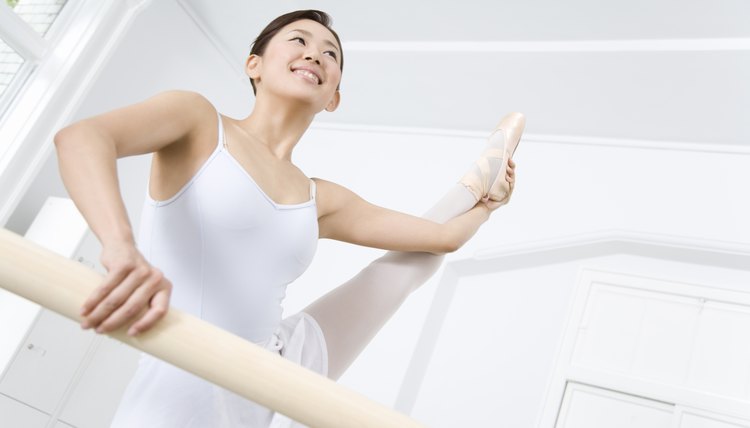Dance Exercise Steps

Despite the growth of alternative cardiovascular classes such as step aerobics and kickboxing, dance aerobics is holding its own. Gone are the headbands and high kicks from the 1980s. Instead, dance exercise uses a variety of moves that can be modified to fit any fitness level. Dance aerobics does not require a dance background or a great deal of coordination. But check with your health care professional to make sure it's safe for you
Aerobic Dance Basics
Dance aerobic choreography is usually put together using 32-beat segments. These segments can be further divided into four 8-count, two 16-count or other variations that equal 32 beats. For example, step-touch for 8 counts, ham curl for 8 counts, V-step for 8 counts and jacks for 8 counts equals 32 counts. An hour-long aerobic dance class usually has four to six 32-count combinations.
Dance aerobic classes are ideal for any fitness level because steps can be modified. Low-impact steps don't involve any hops or jumps, which is good for people with low fitness, heart or blood pressure issues or joint or back pain. The most common low-impact dance steps include step-touch, double step-touch, ham curls, V-steps, grapevines, marching and mambos. Jacks, which is traditionally a high impact step, can be modified to low impact as well. In this case, the dancer taps a foot to one side and then the other while swinging her arms in jacks style.
High-impact steps involve hops or jumps that increase your heart rate for a more challenging workout. Many low-impact steps can be converted to high-impact steps. For example, a hop -- often called a power -- can be added to a double step-touch between the first and second step. V-steps, which are two wide steps forward and two narrow steps back, can be modified to have two hops back. Knee lifts and front kicks can also be modified by adding hops during the lifting phase of the move. Plyometric moves such as squat jumps are also high impact. Other high-impact moves include jacks, jumping rope and pony step.
Aerobic classes feel more like dance with the addition of turn steps. These steps complicate the choreography, so the instructor may need to spend extra time teaching and practicing a turn step to ensure participants learn it.Turn steps usually involve a quarter or 180-degree turn. For example, an L-step is a single step-touch with a quarter turn. You step to the right, turn 90 degrees, step left and step right again, turning back to face the front and finishing with a step to the left. This L pattern can be used in double-steps -- double step L -- and grapevines -- grapevine L -- as well. Other types of turns include diagonal steps, in which the body turns slightly to the diagonal and pivots.
Writer Bio
Leslie Truex has been telecommuting and freelancing since 1994. She wrote the "The Work-At-Home Success Bible" and is a career/business and writing instructor at Piedmont Virginia Community College. Truex has a Bachelor of Arts in psychology from Willamette University and a Master of Social Work from California State University-Sacramento. She has been an Aerobics and Fitness Association of America certified fitness instructor since 2001.
